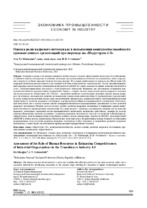| dc.contributor.author | Ху, Минцзюнь | |
| dc.contributor.author | Устинович, И. В. | |
| dc.coverage.spatial | Минск | ru |
| dc.date.accessioned | 2022-12-09T13:25:10Z | |
| dc.date.available | 2022-12-09T13:25:10Z | |
| dc.date.issued | 2022 | |
| dc.identifier.citation | Ху, Минцзюнь. Оценка роли кадрового потенциала в повышении конкурентоспособности промышленных организаций при переходе на «Индустрию 4.0» = Assessment of the Role of Human Resources in Enhancing Competitiveness of Industrial Organizations in the Transition to Industry 4.0 / Минцзюнь Ху, И. В. Устинович // Наука и техника. – 2022. – № 6. – С. 525-534. | ru |
| dc.identifier.uri | https://rep.bntu.by/handle/data/123530 | |
| dc.description.abstract | Развитие кадрового потенциала является необходимым условием эффективной деятельности хозяйственного субъекта любого государства и особенно актуально для развивающихся экономик на современном этапе (стремление к переходу на более высокие технологические уклады). В условиях необходимости перехода на «Индустрию 4.0» кадровый потенциал рассматривается как важный источник конкурентного преимущества. Только квалифицированный персонал может сделать организацию конкурентоспособной на основе лояльности рынка, качества продукции и услуг, дифференцированных продуктов и технологических инноваций. Выявлены два направления повышения конкурентоспособности промышленных предприятий. Первое – оценка системы показателей уровня кадрового потенциала при переходе на «Индустрию 4.0». Второе – выявление наиболее существенных факторов оценки уровня кадрового потенциала, оказывающих влияние на повышение уровня конкурентоспособности промышленных организаций. В статье приведен подробный анализ ряда экономических индикаторов, характеризующих интегральный показатель эффективности развития кадрового потенциала и конкурентоспособности промышленной организации. Интегральный показатель лег в основу модели оценки конкурентоспособности промышленных организаций за счет развития кадрового потенциала. Модель состоит из двух частей: развитие кадрового потенциала и повышение уровня конкурентоспособности промышленных организаций. В основе модели – факторы, оказывающие влияние как на качество кадрового потенциала (кадровый состав промышленной организации, количество работников, уровень их дохода, уровень образования, проекты, связанные с развитием кадрового потенциала), так и на его развитие (общий корпоративный доход, доля вознаграждения сотрудников в общем доходе организации, затраты на НИОКР, доля инвестиций в НИОКР в общем доходе организации, объем продаж и производства). Разработанная модель позволит организациям корректировать свои стратегии развития кадрового потенциала (отбор персонала и дальнейшее развитие кадрового потенциала), а также будет способствовать трансформации корпоративных талантов. | ru |
| dc.language.iso | ru | ru |
| dc.publisher | БНТУ | ru |
| dc.title | Оценка роли кадрового потенциала в повышении конкурентоспособности промышленных организаций при переходе на «Индустрию 4.0» | ru |
| dc.title.alternative | Assessment of the Role of Human Resources in Enhancing Competitiveness of Industrial Organizations in the Transition to Industry 4.0 | ru |
| dc.type | Article | ru |
| dc.identifier.doi | 10.21122/2227-1031-2022-21-6-525-534 | |
| local.description.annotation | Тhe human resource development is a necessary condition for effective activity of any state economic entity and is especially relevant for developing economies at the present stage (striving for transition to higher technological modes). In the conditions of necessity of transition to Industry 4.0 the human resource potential is considered as an important source of competitive advantage. Only qualified personnel can make an organization competitive on the basis of market loyalty, product and service quality, differentiated products and technological innovation. Two directions for increasing the competitiveness of industrial enterprises have been identified. The first is the assessment of the system of indicators of human resource level during the transition to Industry 4.0. The second is to identify the most significant factors in assessing the level of human resources that affect the increase in the level of competitiveness of industrial organizations. The paper provides a detailed analysis of a number of economic indicators that characterize the integral indicator of the effectiveness of the human resources development and competitiveness of an industrial organization. The integral indicator has formed the basis of a model for assessing the competitiveness of industrial organizations through human resource development. The model consists of two parts: human resource development and the increase in the level of competitiveness of industrial organizations. The model is based on the following factors: the quality of human resources (staff composition of an industrial organization, the number of employees, their income level, education level, projects related to human resource development) and its development (total corporate income, share employee remuneration in the total organization income, R&D costs, the share of investment in R&D in the total organization income, sales and production). The developed model will allow organizations to adjust their human resource development strategies (recruitment and further development of human resources), and will also contribute to the transformation of corporate talent. | ru |

